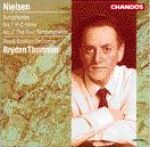NIELSEN
Symphony no. 1 in G minor;
Symphony no.2' The Four Temperaments'
 Royal Scottish Orchestra,
Bryden Thomson
Royal Scottish Orchestra,
Bryden Thomson
 Chandos CHAN 88800 (DDD)
(62.35)
Chandos CHAN 88800 (DDD)
(62.35)
Crotchet
Amazon
UK
Amazon
USA

This is the first volume of the Nielsen symphonies conducted by the late
Bryden Thomson.
The recorded sound is magnificent as is par for the course for Chandos
recordings. The performances are exemplary.
There have been good performances of the Nielsen symphonies over the years.
Paavo Berglund gave a notable account of number 1 and Myung-Whun Chung gave
an outstanding performance of number 2. Bernstein excelled in number 3, whereas
number 4 had an awful recording with Karajan who never understood the work
at all. Sixten Ehrling was a fine advocate of the work. Kondrashin and the
Concertgebouw gave a telling account of number 5 coupled with Sibelius 5.
Number 6,the Sinfonia semplice is a curious work and it would be
charitable for me to say no more about it. There have been some fine readings
of these symphonies in more recent years and some performances have very
good points. But one has to consider all the factors such as tempi,
interpretation, faithfulness to the score, recorded sound quality and whether
the spirit of the music is both caught and realised. Thomson does all of
this. The tempi are well-chosen, the clarity of the texture is always perfect
and the music conveys exactly the composer's intentions.
Nielsen was born into poverty in Funen, Denmark in 1865. He was one of twelve
children brought up in rural isolation. The Symphony no.1 began life
in 1891 when Nielsen was a first violin in the Royal Danish Orchestra. Like
Shostakovich's Symphony no. I this work is very mature and bold. The
opening movement is akin to the glorious sunrise of the Helios Overture
and seems to portray a sunny day with occasional outbursts of oppressive
heat. The andante is a typical Nordic panorama and owes a great deal
to the warm and sunny disposition of late Brahms. The scherzo is sometimes
robust and sometimes cantabile and the finale continues the conflict between
C major and G minor thus giving the music a tension and explaining why there
is no tension or drama say in composers like Schubert.
The symphony's premiere was given by the Royal Danish Orchestra under svendsen
on 14 March 1894 in the presence of royalty. It was a deserved success. The
composer was playing in the orchestra.
It is instantly likeable, a very attractive work and Thomson brings out all
its qualities. His performance is the best available.
The Symphony no. 2 is entitled The Four Temperaments and ,
by this , Nielsen was referring to moods. It was written in his psychological
period when he was attempting to understand human feelings and behaviour
and what affect it had on individuals and their relationships. Instruments
of the orchestra depict personalities, known or unknown. At the time , Nielsen
was completing his opera Saul and David which opera investigates the
relationship that existed between them.... Saul the jealous supremo who had
turned his back on the Divine and David full of arrogance in his knowledge
that he would be king of Israel and therefore preferred to Saul. The moods
in the symphony are the choleric, the phlegmatic, the melancholic and the
sanguine. But such titles are confusing. Just enjoy the music. The first
movement is in sonata form and rooted in B minor with two contrasting theme,
one petulant and the other a broad thoughtful theme. Passion is never far
away. The second movement is irresistible in this performance and has a story
behind it of a beautiful blue-eyed teenage boy who was uncommonly loveable.
It tells of his mother's love for him and the story can be open to many
interpretations. Yet the music has an innocence unlike Britten's sordid
Death in Venice. The slow movement is melancholy but never depressing
although it is expressed in dark tones. This performance is very profound
but never drags or loses interest. The conductor has bound it together very
successfully.
The finale is a rondo and is one of Nielsen's finest creations. It has elan
and excitement and the trombones are very impressive. By contrast ,they are
ridiculed in the Symphony no.6 but this finale is electric, alive,
stunning and typical of Thomson's superlative insight into the music.
You will not hear it played better. Two hugely enjoyable symphonies.
I am sure they have been reviewed many times before but this review serves
as a reminder to the unrivalled excellence of these performances.
David Wright
Performances

Recording

